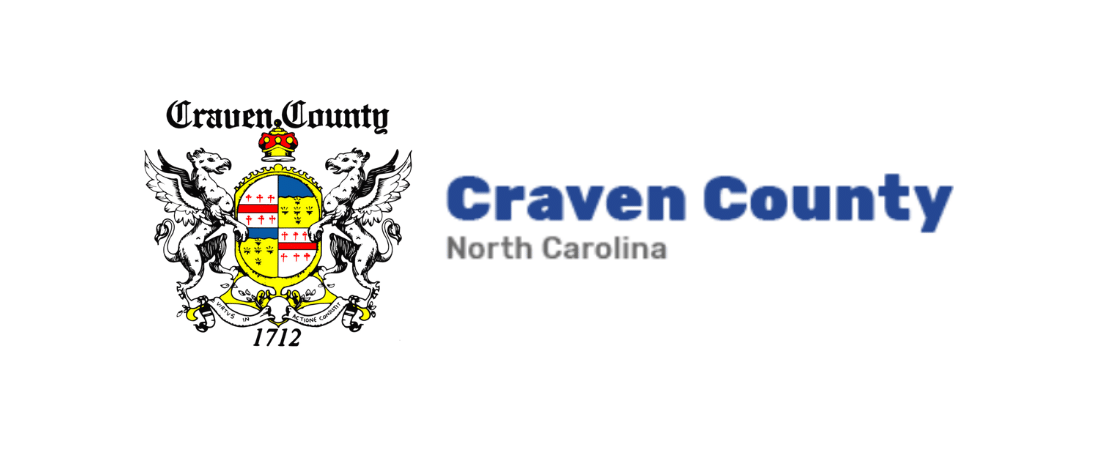
Craven County Emergency Services is preparing for potential winter weather expected to affect Craven County as early as Thursday evening and throughout the weekend. Information from the National Weather Service’s Winter Weather Preparedness materials has been combined to provide citizens with information on how to prepare, and how to stay safe, should winter weather affect the Craven County area.
In general, citizens should:
- Have enough food, water, and prescription medications on hand to last all household members and pets at least until Monday. Citizens with home medical needs such as oxygen, should be prepared to have enough to last them without assistance through Monday. Contact suppliers today to be certain spare oxygen is onsite in case of power failure.
- Avoid carbon monoxide risks by keeping generators well away from the home. Never run a generator, charcoal grill, gas grill or camp stove in your home, garage, or any other enclosed area. Carbon Monoxide can be a silent killer.
- If weather is bad, stay home unless it is necessary to travel.
- Being prepared for winter weather means having the necessary information to make the right decisions. The National Weather Service recommends that you regularly check its website or tune into NOAA Weather Radio, local television and local radio in order to keep informed of weather conditions and forecasts.
Snow and ice preparedness:
Is your home prepared for winter? We think of our homes as the place we want to be when the weather turns cold and blustery. However, if certain precautions are not taken before a winter storm strikes, life at home can be just as miserable as the weather outside.
Severe winter storms produce conditions which can isolate you in your home for several days. Prolonged loss of power and telephone services can severely limit your ability to heat your home and call for help. In severe winter storms, obtaining supplies, food and other necessities can be hampered or prevented by poor road conditions. The following are some helpful hints to make your home a safe haven during winter weather.
- Stock an emergency supply of food and water prior to the onset of a winter storm. Include food items which require no cooking such as canned meats, peanut butter and other non-perishables. Also do not forget to have necessary medicines and baby items on hand. A three-to-five-day supply of food and medicine is generally sufficient. Also make sure you have a manual can opener.
- Keep an adequate supply of heating fuel (firewood, kerosene, etc.) at your home. Use your fuel properly and sparingly as supplies may be in short order during winter storms. Use heaters and fuels properly and safely to avoid deadly fires and carbon monoxide.
- Keep on hand a flashlight, battery powered radio, extra batteries, and a first aid kit.
- Prevent water pipes from freezing by wrapping them with insulation or newspaper covered with plastic. In really cold weather, let your faucets drip slightly to help avoid freezing. If your pipes do freeze, remove the insulation and wrap the pipes in rags. Open every faucet in the house and pour hot water over the rag wrapped pipes. Also, know how to shut off your home’s water supply should water lines break.
- Keep generators well away from the home. Never run a generator in your garage or any other enclosed area. Carbon monoxide from the exhaust of the generator can be a silent killer. Also make sure your generator is properly wired to your home. Never heat your home using a charcoal grill, gas grill or camp stove. Grills and camp stoves create deadly carbon monoxide fumes that will build up when used in your home. Always use grills outside.
- Due to the use of alternative heating sources, house fires can be a real danger during winter storms, so make sure that every family member knows how to evacuate the home in the event of a fire. Make sure you and your family designate an outdoor meeting place if you do have to leave your home quickly because of a fire. Also make sure all smoke detectors are working properly and have fresh batteries.
- Trim weak or damaged tree branches around your home, and do not park vehicles under trees.
- Keep your mobile and electronic devices charged.
Heavy wet snow accumulations combined with wind can bring down trees and power lines. In rural areas, heavy snow can isolate people in their homes for days. Driving in snow can become very hazardous the very moment snow starts to stick to the road. The majority of all winter related deaths occur in automobiles when cars slide on slippery roads causing accidents. With this in mind, when snow falls and roadways become dangerous you should only travel when absolutely necessary. Staying off the road during snow and ice also allows department of transportation crews time to clear and treat roads surfaces.
Freezing rain and sleet dangers:
Ice falling in the form of freezing rain is particularly dangerous and poses a variety of problems. Freezing rain occurs when liquid precipitation, which could be rain or melted snow, strikes a surface that is below freezing. In this scenario temperatures at the surface are below freezing while at least a portion of the atmosphere is above freezing. The liquid precipitation freezes upon contact with the ground, trees, power lines and roadways.
The ability of freezing rain to accumulate on nearly every surface including trees, power lines, and bridges makes it one of the most dangerous forms of winter weather. As little as a quarter inch of freezing rain can create widespread power outages as experienced during the December ice storm of 2002, when nearly an inch of freezing rain brought down countless trees and power lines. Over one and half million people in North Carolina lost power during the 2002 ice storm.
Just small amounts of freezing rain can cover the pavement and especially bridges with a solid glaze of ice making driving extremely dangerous and nearly impossible. The majority of ice storm deaths are traffic related. Freezing rain will even accumulate on the steps and railings of your home making going out the door hazardous. Many injuries occur every year when people slip on ice.
Sleet can also be dangerous for motorists. Sleet forms when a raindrop falls and encounters freezing temperatures above the earth’s surface and freezes into an ice pellet just before reaching the ground. Sleet can accumulate very efficiently on roads and sidewalks. Since sleet is a small solid ball of ice it usually accumulates more efficiently than snow. This is why sleet can make roadways and walkways very dangerous in just a short amount of time.
When driving, ice can be very difficult to recognize. The roadway may appear to be wet when in reality what appears to be water may actually be ice. If the temperature outside is below freezing, ice can form on the roads, especially on bridges and overpasses. When encountering ice, do not panic and do not stomp on your brakes. Striking your brakes will cause your car to slide into a skid. It is safer to slowly decelerate to a stop. Driving slow and defensively goes a long way when driving on ice and snow.
Driving in winter weather:
The majority of all winter weather related deaths occur on the road, either in accidents or by people becoming stranded. When the weather is bad and driving conditions are poor, the best bet is to stay at home. However, if you must venture out, the following tips could make for a safer journey.
- Make sure your car is in good running condition. Make sure that your battery, antifreeze, windshield wipers, ignition and thermostat are all in good working order. Be sure your tires have enough tread. Replace any of these items if necessary.
- If you must go out when snow and ice are on the ground, let someone know your destination and when you plan to arrive. Also take a cell phone with you if possible.
- Clean snow and ice off all parts of your car before you drive away.
- Keep your gas tank as full as possible when snow and ice are forecast. This will not only give you added peace of mind, it also increases the weight of your car and this will provide additional traction.
- Keep the following basic items in your car – windshield scraper and brush, booster/jumper cables, a tow chain or rope, bag of sand or salt, blankets, flashlight, first aid kit and road map.
- Overall drive slowly. Driving at even posted speeds is extremely dangerous when snow and ice are on the road. Many vehicles will lose traction especially at higher speeds resulting in serious accident and vehicle rollovers.
- Steer your car into the skid. If your vehicle loses traction and begins to skid, steer the front tires into the direction of the skid. Never hit your brakes as this will result in a more serious skid and spinning of the vehicle. When your vehicle skids keep your cool and remain calm. Driving at slower speeds will help you recover from a skid.
If you get stranded on the road:
- Stay in your car! Do not seek alternate shelter unless it is close by or already visible. You can easily become disoriented in heavy snow and cold temperatures. Take a cell phone with you when you travel if possible.
- Periodically turn on the car engine for brief periods. This will help provide heat to the inside of the car. However, to avoid carbon monoxide gas buildup, clear the exhaust pipe of snow and leave a downwind window slightly open for ventilation.
- Make yourself visible by tying a colored cloth to your antenna or door, or by turning on your dome light when running the engine.
Winter Fire Danger:
Home fires occur more in winter than in any other season. According to the National Fire Protection Association, half of all home heating fires occur during the winter months. Heating equipment is involved in 1 in every 7 home fires and 1 in every 5 home fire deaths. Here are some safety tips to reduce this risk.
- Keep anything that can burn at least 3 feet from any heat source like fireplaces, wood stoves, radiators, or space heaters.
- To avoid a carbon monoxide poisoning risk, keep portable generators outside away from windows and as far away from your home as possible.
- Install and test carbon monoxide alarms at least once a month.
- Plug only 1 heat-producing appliance, like a space heater, into an electrical outlet at a time.
- Have a qualified professional clean and inspect your chimney and vents every year.
- Store cooled ashes in a tightly covered metal contains and keep it outside at least 10 feet from your home and any nearby buildings.
Additional winter weather preparedness resources:
NWS winter safety page: https://www.weather.gov/wrn/winter_safety
North Carolina Department of Public Safety preparedness page: https://readync.org
FEMA’s Winter preparedness page: https://www.ready.gov/winter-weather
Craven County Government Emergency Management updates will appear on the Craven County website at www.cravencountync.gov, on the Craven County Facebook page @cravencounty and the Craven County Twitter account @cravencountync. Visit the Craven County Emergency Services website to register to receive emergency notifications via text, email and phone calls through the CodeRed Emergency Notification System at https://www.cravencountync.gov/175/Emergency-Services.
By Amber M. Parker, Human Resources Director, Craven County Human Resources

